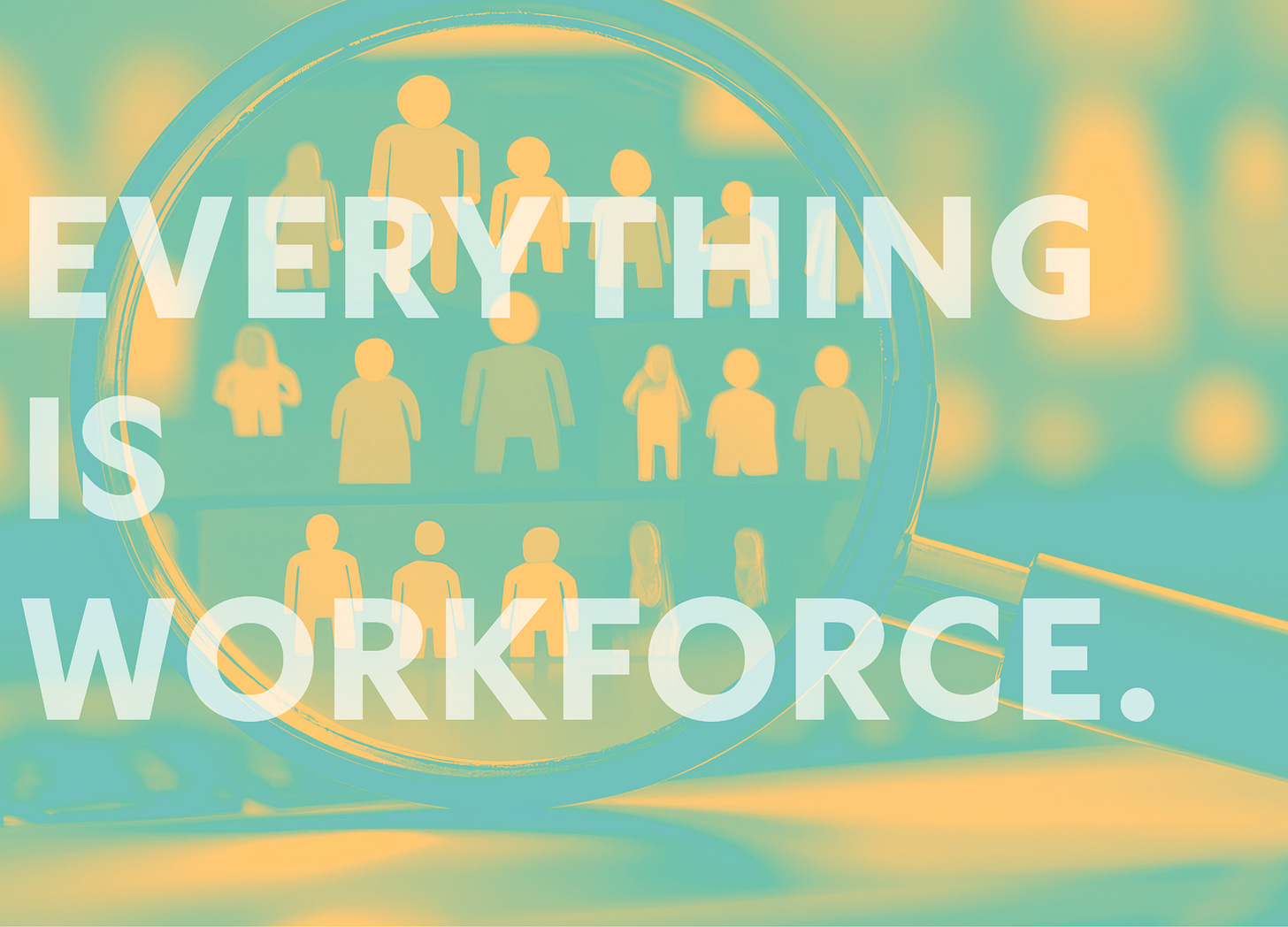Why getting people jobs is harder without equity.
The War on ‘Woke’ is also a war on workforce development that works.
The issue
The Trump Administration is trying to get rid of strategies to improve workforce diversity, equity, inclusion, and accessibility. It also seems like it wants to get more people into jobs.
But you can’t get more people jobs without trying to get more people jobs—which is much harder without strategies that the Administration calls “illegal DEIA.”1
Wait, what?
The definition of “workforce development” I use around here is “getting more people who need jobs into jobs that employers need to be filled.”2 The hardest part of getting people into jobs that need to be filled? Getting people hired.
Hiring is a mess. Many hiring managers try to avoid taking risks because safe picks—even if “safe” is not actually “good”—won’t reflect that badly upon them.
So, for a risk-averse hiring manager, what can a “safe” hire look like?
They’re more likely to be extroverts, who can earn up to $600,000 more than introverted peers because they are comfortable talking about themselves and have stronger people skills.
They are more likely to be a college graduate, with college graduates having half the unemployment rate of workers with only a high school diploma, and especially if they come from a background that let them glide into extracurricular activities and networking key for getting jobs in the future.
If it’s a better-paying white-collar job, there is a good chance the hire came from a white-collar family, which invested time and resources in teaching them skills and tricks key to navigating a white-collar workplace.
You might have heard that there are (or at least were) a lot of open jobs. Three million open trade jobs. Hundreds of thousands of manufacturing jobs. An untold number of IT, cybersecurity, and AI jobs. Something like that.
Filling all these jobs means getting hiring managers to increase their risk tolerance. There are only so many people who have the pack of characteristics I list above:
57 percent of people are introverted, meaning they can really struggle with long periods of peopling needed to get a job.
Because of cost or just not seeing the point, fewer Americans are attending or finishing college, and 80 to 90 percent of the people who live in some rural parts of the country already didn’t have a degree. Even if people did go to college, they might have had to work their way through school, costing them the opportunities to make connections that make it much easier to get a job down the line.
People from lower-income backgrounds are less likely to know the codes and etiquette that can have an outsized role in white-collar interview processes.
So how do you help get workers over the hump to getting hired and employers to see that the worker coming over the hump is hirable?
Well…
Here are a few things that a good workforce development program can do to help employers and workers find each other.
Coaching people who have trouble interviewing to understand all the little cues that employers could be looking for—and counseling employers on whether those cues are costing them good talent.
Working with employers to remove degree requirements and hire based on a broader range of qualifications, including measured skills and non-degree credentials.
Providing this thing called “skills training,” including durable or “soft” skills someone may lack because of their background and experience.
All these ideas are effective practices at getting more people into jobs that need filling—the dream of many an elected political leader.
Except many of the most effective strategies that bring together employers and workers are DEIA activities that the Trump Administration and large employers3 have turned on.
Whoops.
Explain yourself.
You might have noticed I wrote an entire section about diversity, equity, inclusion, and accessibility without mentioning race, gender or gender identity, disability, or any other protected status. That was to prove a point.
Getting more Americans jobs means helping them get past the things preventing them from getting jobs. Sometimes it’s their being a little shy during interviews. Sometimes it’s their being caught in the gears of multigenerational structural biases or outright deliberate efforts that prevent people of color or gay people or people with disabilities from getting jobs.
These things aren’t separated into neat little buckets. The reason somebody thinks they’re terrible at interviewing, for example, can be bound up in class and race and perceptions of their ability. People tell folks who look or speak or seem a certain way that they are not able to do a thing. Or that they need to be different if they’re going into a space where someone is giving them an opportunity.
They tell them this a lot. It sticks. Sometimes people figure out a way around by themselves, often they don’t.
Workforce development is most effective when it partners with employers to see beyond the stuff that doesn’t really matter and helps workers gain the skills and confidence they need to get a good job.
This is painfully clear in a strategy of a note for the Trump Administration and members of Congress: creating more good-paying jobs that don’t require a college degree.
Again, the biggest challenge can be getting people hired. Most employers still put a lot of value in college degrees—80 percent of them, in fact. It’s very hard for a worker without a degree to get through a hiring process where the employer hasn’t taken steps to account for and minimize that bias.
And if you’re the only person without a degree in the office, it can be harder for you to stick around if you don’t get help from a mentoring program or other proactive steps by your managers that make it clear you’re a member of the team, not a cool thing the company kind of tried once.
Luckily, there is a well-developed box of tools to help workers like these get and keep a good job.
…
Whoops.
What do we do about it?
Let’s talk about how to pursue techniques that might be called “DEIA” that, if applied broadly for some reason, still can get more people into jobs.
Mentor everybody.
Mentoring allegedly is in a safe zone programmed into recent Trump Administration actions. I’m a big fan of well-assembled mentorship programs that carefully and curiously identify where a participant has gaps and fills them in. If you’re doing this for everyone in your program, it’s very hard for someone to argue that you unfairly promoted one group over another.
Play fair.
I used to underestimate the value of career fairs, but there are employers who show up to these events very sincerely looking for new talent, especially if they trust the organizer to bring the goods. I have talked to successful former workforce program participants who said fairs were the first time they met and interacted with higher-paying employers who really gave them a shot at good job.
It’s very hard to argue that a job fair with a big crowd is some sort of targeted effort to hire one “unqualified” person from an underrepresented group. It’s also very hard to claim the person didn’t get a job based on merit If they stood out among a crowd.
Go blind.
Where possible, I would help employers set up blind resume reviews to focus more on skills and qualifications, which can help minimize bias toward people with degrees, among others. Blind reviews—where the hiring team scrubs names and colleges and the like from resumes provided evaluators—have been effective in minimizing the impact of race and gender bias. Given employers’ pro-degree bias and the slow uptake on actual hiring of people without degrees, it’s a good strategy to try for giving more workers a shot.
Admittedly, this is the riskiest of the strategies I recommend because it has clear equity ties. The Administration has not expressed opposition to blind resume reviews, but the Trump II Education Department has thrown its weight against removing standardized testing scores from college applications.4 That is not exactly opposition to blind resume reviews, but it definitely lives in the same zip code.
Yet, it’s hard to argue that a blind resume review doesn’t fit within the Trump anti-”DEIA” philosophy of not giving one worker undue “help” at the cost of people who deserve the job on merit. If you were to take the Administration at its word for why it is pursuing “DEIA” bans, a blind resume review would erase any signals of protected class that might lead a reviewer to favor purportedly “unqualified” candidates. Logically, listing accomplishments without telltale details would favor candidates who do deserve the job based on merit.
Or so one would think.
Card subject to change and programming note.
I’m taking a small vacation next week. By “small” I mean “a trip planned for multiple years,” and by “vacation” I mean “chasing two increasingly clever velociraptors adorable and rambunctious children around a theme park of note and hoping they don’t lead the dinosaur uprising aren’t afraid of people in costumes.”
Next Tuesday, you’ll still get me in your inbox but most likely in a “Best of” post from my hardscrabble early days in [checks notes] February, before two-thirds of you signed up. I say “most likely” in the odd case that I clever myself into writing something on one of my plane rides this week.
Friday, I may be a little later than usual because of work travel up north. My “JAYSON TATUM NEEDS TO BE ON THE BENCH” shirt will play well at Logan Airport, right?
FRIDAY: About that FEMA funding news, an interesting detail I spotted in “illegal DEIA” ban efforts in workforce dollars, and $2.2 billion in workforce dollars. Maybe.
IN TWO WEEKS: Legal and legal-ish cannabis products make a lot of money. Are the jobs any good, and how do you fill the workforce needs of an industry under constant suspicion?
For newer readers: I put “DEIA” in quotes in reference to the Trump “illegal DEIA” executive orders and other anti-DEIA initiatives that do not define what “DEIA” is and often describe actions authorized, if not directed, by the law.
If you want something longer, this is a pretty good one that gets at the same idea.
This definitely isn’t every large employer but, respectfully, if I have read your leadership grousing for four years about how “DEIA doesn’t work” or “DEIA needs to go away” or “DEIA is going away,” are you really rolling back DEIA now because of President Trump? And did you really make an effort in the first place?
I’m a big supporter of abolishing standardized testing, which tend to grade your ability to pay for test prep courses, not your potential as a human or likelihood for success in college. Future newsletter.







